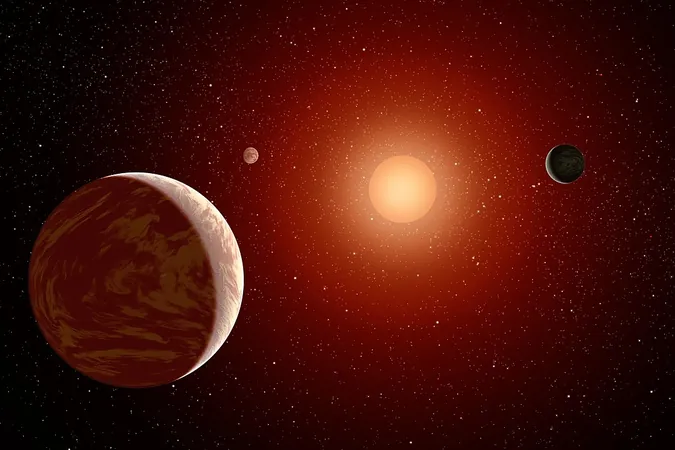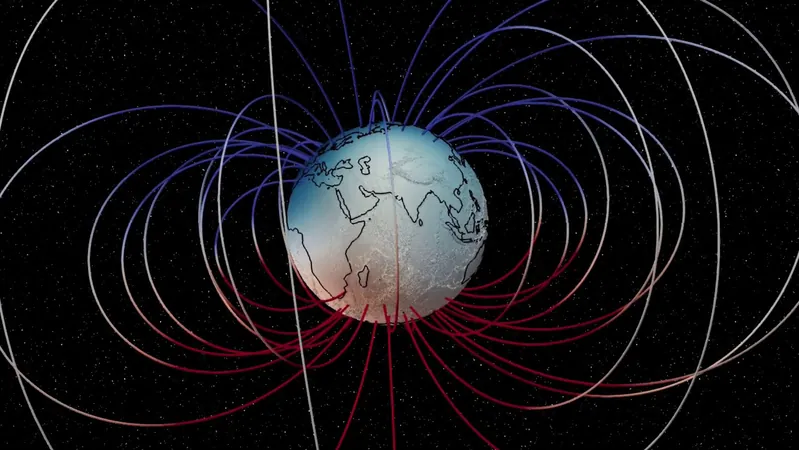
Groundbreaking Discovery: Giant Exoplanet in Binary System Challenges Our Understanding of Planet Formation Around Red Dwarfs!
2024-10-10
Author: Arjun
Groundbreaking Discovery: Giant Exoplanet in Binary System Challenges Our Understanding of Planet Formation Around Red Dwarfs!
In an exciting revelation that could reshape our understanding of planet formation, astronomers have discovered a giant exoplanet in a binary system involving red dwarf stars—a phenomenon that could explain how these cooler, low-mass stars manage to form massive planets.
The astronomical community has witnessed an explosion in the number of confirmed exoplanets, now totaling 5,799 across 4,310 star systems, with countless more candidates pending verification. A particularly intriguing aspect of this trend is the prevalence of rocky planets and gas giants orbiting M-type (red dwarf) stars, which are known for their relatively low temperatures and masses.
One such star system is TOI-6383, located approximately 560 light-years from Earth, which consists of two red dwarfs: the primary star, TOI-6383A, and its smaller companion, TOI-6383B. A collaborative study led by Lia Marta Bernabò, a PhD astronomy student at the University of Texas at Austin, along with the GEMS (Searching for Giant Exoplanets around M-dwarf Stars) survey team, has revealed the presence of a giant planet, designated TOI-6383Ab, that is comparable in size and mass to Jupiter. This giant planet orbits TOI-6383A, completing a full revolution every 1.79 days.
The TOI-6383A star is about 46% the mass of our Sun and has a surface temperature around 3444 K (3,170 °C), whereas its companion, TOI-6383B, is even smaller at 20.5% the mass of the Sun. The findings have been accepted for publication in the Astronomical Journal, further emphasizing the significant contributions of the GEMS survey, which includes collaborations from esteemed institutions such as NASA’s Goddard Space Flight Center and ETH Zurich.
A critical aspect of the GEMS survey is the use of the Transit Method, where astronomers monitor stars for drops in brightness that may indicate a planet transiting in front of them. This technique, aided by NASA's Transiting Exoplanet Survey Satellite (TESS), has been key to confirming the existence of TOI-6383Ab.
These discoveries have sparked vital discussions in the scientific community concerning the mechanisms by which planets form around red dwarfs. Traditionally, two models have dominated the dialogue: the core-accretion model, which suggests that planets develop from the gradual accumulation of material around a solid core, and the rapid formation model, which posits that massive protoplanetary disks can fragment at an accelerated pace, leading to the creation of planets from clumps of material.
The existence of TOI-6383Ab poses critical questions for both models, especially since most dwarf stars possess smaller protoplanetary disks that seem insufficient for forming such gigantic planets through core accretion alone. So far, only 20 massive exoplanets have been identified around M-type stars, but the GEMS project aims to discover at least 40 such planets, providing an opportunity for further scrutiny of these competing formation theories.
This remarkable discovery not only sheds light on the dynamic process of planet formation in binary systems but also emphasizes the complexity and diversity of planetary systems that red dwarfs can host. As research continues, we are only beginning to unveil the mysteries of our universe—the discovery of TOI-6383Ab may just be the tip of the iceberg! Stay curious as astronomers dive deeper into these cosmic enigmas!





 Brasil (PT)
Brasil (PT)
 Canada (EN)
Canada (EN)
 Chile (ES)
Chile (ES)
 España (ES)
España (ES)
 France (FR)
France (FR)
 Hong Kong (EN)
Hong Kong (EN)
 Italia (IT)
Italia (IT)
 日本 (JA)
日本 (JA)
 Magyarország (HU)
Magyarország (HU)
 Norge (NO)
Norge (NO)
 Polska (PL)
Polska (PL)
 Schweiz (DE)
Schweiz (DE)
 Singapore (EN)
Singapore (EN)
 Sverige (SV)
Sverige (SV)
 Suomi (FI)
Suomi (FI)
 Türkiye (TR)
Türkiye (TR)